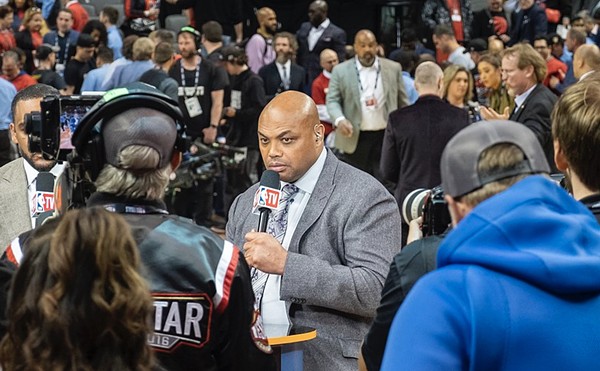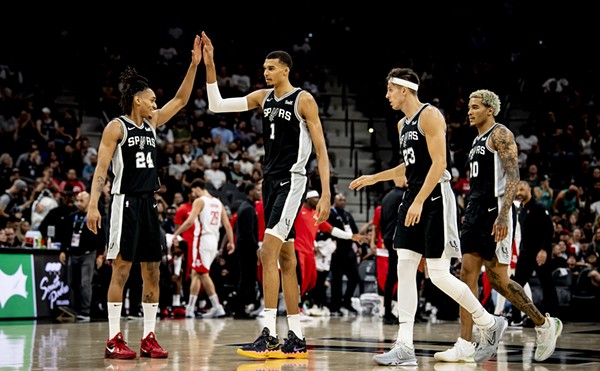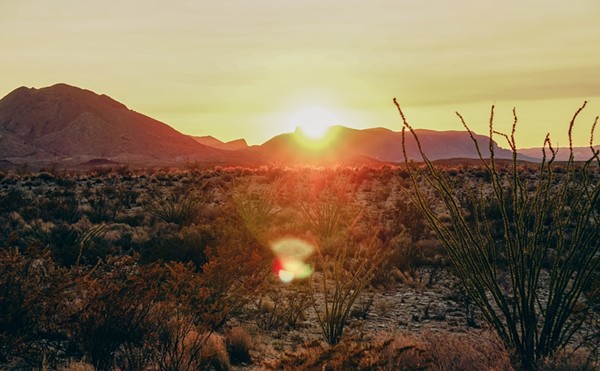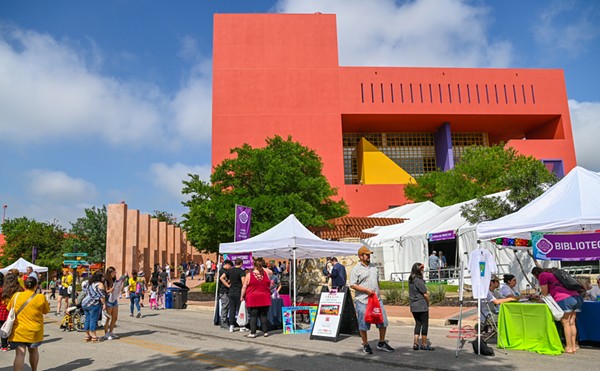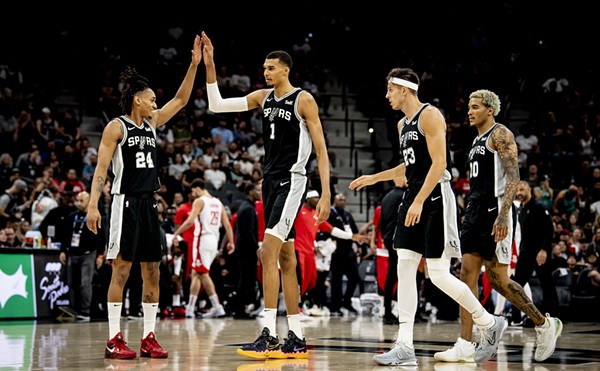Some artists don’t get stuck. When Tracey Moffatt hit the art scene 20 years ago, she quickly became known as a new voice from the Aboriginal communities of Australia, her knack for storytelling displayed first in still photography and later in film often depicted racial and class mashups — behavior that strayed dangerously from convention, often with dark consequences. Both still and moving images by Moffatt are now on view at Artpace in a virtuosic display of sampling that reworks found photographs and makes raids on classic film and TV stock, to sometimes-hysterical result.
Rounding the walls of the Hudson (Show)Room is “First Jobs,” 12 digital prints made in 2008 from found 1970s photographs, adapted to depict minimum-wage job sites. Moffatt has copied and reworked the originals by inserting her smiling image and has manipulated the color to the over-bright but faded hues of old postcards. The scenes feature jobs that Moffatt held while in school, or shortly after. Some of the prints, like Pineapple Cannery, point to her tropical North Australian youth. Others, such as Hair Washer or Fruit Market, only reveal their site and era in fashion and décor details. The collection of happy workers can be read as a paean to youthful optimism and the first experiences of workday camaraderie — it’s all so romantic, as cheerful as the happiest of Soviet socialist realism or Nazi art. Taken straight up or with a twist of irony, they sparkle.
In a darkened viewing room is “Handmade,” a series of video montages made between 1999 and 2010. Moffatt began her career in commercial television; here she acts as director. The videos were pieced together by her collaborator and film editor, Gary Hillberg. Clips sourced from dozens of old films and American television series are spliced together to reveal genres, making new short stories using bits that repeat like hip-hop sampling. Often clusters of similar actions — a kiss, a crying child, or a slap — spray like shotgun blasts or startled flocks of birds.
The earliest of the montages, Lip, a 10-minute piece made in 1999, shows relations between rich white folk and their African-American servants. Following standard linear convention, it begins with servitude, then moves to offense and ends with happy revolt. One of the later pieces, Revolution, made in 2008, acknowledges the circular nature of video installation. It is made to loop, revolving from scenes of crowned heads gleaned from period films, to storming crowds, and back again to an extended shot of a crown, this time on a young child.
The most disturbing of the collection are Mother, made in 2009 and Love, 2003. Though made both late and early in the series, they both are unrelenting in using Hollywood’s cunning, the ability of cinema to manipulate emotion. Mother pushes buttons nonstop for an unbearable 20 minutes, with tender scenes of children segueing to those of loss, abandonment, and grief. The viewer is constantly reminded that she is being manipulated, but that knowledge does not save her from an emotional tossing. It works because we have learned these tropes. Even in black and white, a child’s cry hurts. Perhaps especially so because we are aware of ourselves as viewer, not participant. This is story.
The most recent of the seven montages is declared by Moffatt to be the last in the series. Other, made in 2010, sources scenes like Marlon Brando encountering native charm in Mutiny on the Bounty; older clips are clearly racist, presenting near-naked dancing dark bodies in segments from movies made during the last decades of the British Empire. Racial mixing, miscegenation, has long been one of Moffatt’s themes, but here it is presented without societal retribution as pure erotica. Countering politically correct dismissals of exoticism, there is unbridled sexual fascination with the other, a fest of multi-culti dalliance surveying prohibitions from bi-racial to homoerotic coupling, culminating in — of course — orgasmic explosions. But hey, it’s the movies.
Viewed street-side is WindowWorks, this time the site for two peephole displays by San Antonio-based artists Leslie Raymond and Jason Jay Stevens, who use the name Potter-Belmar Labs as their art handle. Thirteen Views in Arid Lands are time-lapse 360-degree views chronicling a journey of some sort, a quest. Tiny images shuffle slowly, interrupted by text, blacking out to another survey. The aperture is positioned low and a few inches within the glass, not at all easy to approach. But after experiencing the excesses of the Moffat shows, the slow, small march of trees, hills, and urban wasteland offer a helpful cooling down.
Tracey Moffatt
Free
Noon-5pm Wed-Sun
Artpace, 445 N Main
(210) 212-4900
On view to September 11




